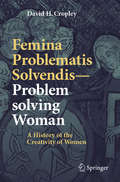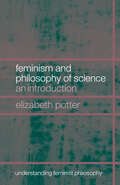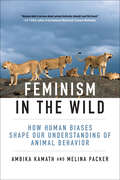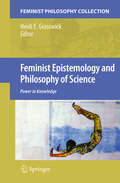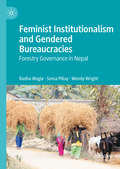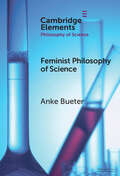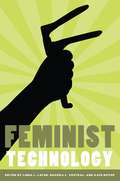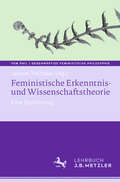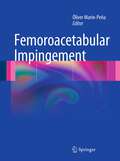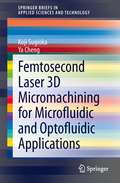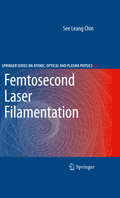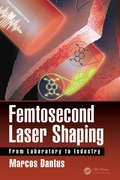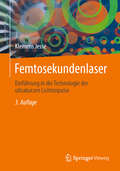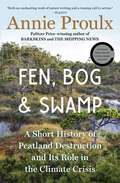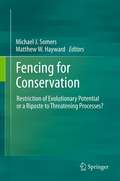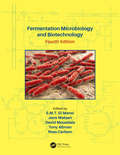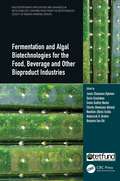- Table View
- List View
Femina Problematis Solvendis—Problem solving Woman: A History of the Creativity of Women
by David H. CropleyThis book explores the history of modern human creativity/innovation, highlighting examples of solutions to basic human’ needs that have been developed over time. The title – Femina Problematis Solvendis – is a play on the scientific classifications of humans (Homo habilis, Homo erectus, Homo sapiens), but with special focus on inventions pioneered by women (“femina”) and is intended to suggest that a defining characteristic of modern humans is our fundamental ability to solve problems (i.e., problem-solving woman = Femina problematis solvendis), Written by David H. Cropley, an internationally recognised expert on creativity and innovation, it also builds on his previous book “Homo Problematis Solvendis –Problem-solving Man”, published in 2019. The book explores innovations over ten distinct “ages” of human history, beginning with “prehistory”, and moving up to the present “information age”. Each era is covered by a dedicated chapter that describes three key innovations that were either definitely invented by a woman or can be plausibly attributed to a female inventor. The book’s focus on female inventors also serves to highlight some of the ways women have been treated in societies over time.
Feminism and Philosophy of Science: An Introduction (Understanding Feminist Philosophy)
by Elizabeth PotterReflecting upon the recent growth of interest in feminist ideas of philosophy of science, this book traces the development of the subject within the confines of feminist philosophy. It is designed to introduce the newcomer to the main ideas that form the subject area with a view to equipping students with all the major arguments and standpoints required to understand this burgeoning area of study. Arranged thematically, the book looks at the spectrum of views that have arisen in the debate. It is broadly arranged into sections dealing with concepts such as the notion of value free-science, values, objectivity, point of view and relativism, but also details the many subsidiary ideas that have sprung from these topics.
Feminism in the Wild: How Human Biases Shape Our Understanding of Animal Behavior
by Melina Packer Ambika KamathHow dominant culture—from sexism and homophobia to racism, capitalism, ableism, and more—has limited the science of animal behavior, and how we can free ourselves from these limited perspectives.In Feminism in the Wild, Ambika Kamath and Melina Packer reveal how scientists studying animal behavior have long projected human norms and values onto animals while seeking to understand them. When scientific studies conclude that these norms and values are natural in animals, it makes it easier to think of them as natural in humans too. And because scientists, historically and to this day, largely belong to elite, powerful segments of society, the norms and values embedded in animal behavior science match those of the already powerful. How can animal behavior science escape this trap of naturalizing dominant culture?Drawing from decades of feminist, antiracist, queer, disability justice, and Marxist contributions—including those of biologists—Kamath and Packer break down persistent assumptions in the status quo of animal behavior science and offer a multitude of alternative approaches. Core concepts in animal behavior science and evolutionary biology—from sex categories and sexual selection to fitness, adaptation, biological determinism, and more—are carefully contextualized and critically reexamined. This unique collaboration between an animal behavior scientist and a feminist science studies scholar is an illuminating and hopeful read for anyone who is curious about how animals behave, and anyone who wants to break free from scientific approaches that perpetuate systems of oppression.
Feminism, Time, and Nonlinear History
by Victoria BrowneInterweaving phenomenological, hermeneutical, and sociopolitical analyses, this book considers the ways in which feminists conceptualize and produce the temporalities of feminism, including the time of the trace, narrative time, calendar time, and generational time.
Feminist Epistemology and Philosophy of Science
by Heidi E. GrasswickHaving enjoyed more than twenty years of development, feminist epistemology and philosophy of science are now thriving fields of inquiry, offering current scholars a rich tradition from which to draw. In addition to a recognition of the power of knowledge itself and its effects on women's lives, a central feature of feminist epistemology and philosophy of science has been the attention they draw to the role of power dynamics within knowledge-seeking practices and the implications of these dynamics for our understandings of knowledge, science, and epistemology. Feminist Epistemology and Philosophy of Science: Power in Knowledge collects new works that address today's key challenges for a power-sensitive feminist approach to questions of knowledge and scientific practice. The essays build upon established work in feminist epistemology and philosophy of science, offering new developments in the fields, and representing the broad array of the feminist work now being done and the many ways in which feminists incorporate power dynamics into their analyses.
Feminist Institutionalism and Gendered Bureaucracies: Forestry Governance in Nepal
by Soma Pillay Wendy Wright Radha WagleThis book examines the processes for the inclusion of women, and the role of women employees in Nepal’s forestry bureaucracy. The book adopts a “gender lens” drawn from feminist institutionalism and is framed around the following four objectives: evaluating the effectiveness of current legislative and policy frameworks for the inclusion of women in the Nepalese forest bureaucracy; examining the dynamics of organizational culture, formal and informal institutions, and structure and agency in and around forest bureaucracy in Nepal; assessing power relations in forestry institutions focusing on influential participation of women forestry professionals in the bureaucratic structure; and gaining insights about the alternative space of feminist institutionalism in connection with women inclusive forest bureaucracy.Findings in the book inform and extend feminist institutionalism perspectives by applying it to a context which remains under explored, providing insights on the efficacy of public sector cultural change, especially as it relates to those areas within bureaucracies less in a position to adopt the changes mandated by society and principles of good governance.
Feminist Philosophy of Science (Elements in the Philosophy of Science)
by Anke BueterFeminist scholars have identified pervasive gender discrimination in science as an institution, as well as gender bias in the very content of many scientific theories. An ameliorative project at heart, feminist philosophy of science has inquired into the social and epistemological roots and consequences of these problems and into their potential solutions. Most feminist philosophers agree on a need for diversity in scientific communities to counter the detrimental effects of gender bias. Diversity could thus serve as a unifying concept for a potential consensus of the field. Yet there are substantial differences in the kinds and roles of diversity envisaged. This element argues that we need diversity, both in terms of social locations and of values, to overcome former biases and blind spots. Diversity as such, however, is insufficient. To reap its epistemic benefits, diversity also needs to be institutionalised in a way that counters various forms of epistemic injustice.
Feminist Technology (Women, Gender, and Technology)
by Linda L. Layne Sharra Vostral Kate BoyerIs there such a thing as a "feminist technology"? If so, what makes a technology feminist? Is it in the design process, in the thing itself, in the way it is marketed, or in the way it is used by women (or by men)? In this collection, feminist scholars trained in diverse fields consider these questions by examining a range of products, tools, and technologies that were specifically designed for and marketed to women. Evaluating the claims that such products are liberating for women, the contributors focus on case studies of menstrual-suppressing birth control pills, home pregnancy tests, tampons, breast pumps, Norplant, anti-fertility vaccines, and microbicides. In examining these various products, this volume explores ways of actively intervening to develop better tools for designing, promoting, and evaluating feminist technologies. Recognizing the different needs and desires of women and acknowledging the multiplicity of feminist approaches, Feminist Technology offers a sustained debate on existing and emergent technologies that share the goal of improving women's lives. Contributors are Jennifer Aengst, Maia Boswell-Penc, Kate Boyer, Frances Bronet, Shirley Gorenstein, Anita Hardon, Deborah G. Johnson, Linda L. Layne, Deana McDonagh, and Sharra L. Vostral.
Feministische Erkenntnis- und Wissenschaftstheorie: Eine Einführung (fem.phil | Gegenwärtige feministische Philosophie)
by Liane Meyer Marius ThienenkampWie hängen Wissen und Politik zusammen? Wie beeinflussen Gender und andere soziale Faktoren wissenschaftliche Untersuchungen? Wie formt unsere kulturell-historische Verankerung unser Denken über die Welt? Diese und weitere Fragen werden in der feministischen Erkenntnis- und Wissenschaftstheorie diskutiert, die sich in den 1970er Jahren im Zuge der internationalen Frauenbewegungen zunächst als feministische Kritik an sexistischen wie auch rassistischen Ideologien in der Wissenschaft entwickelte. Mittlerweile ist sie zu einem interdisziplinären Diskurs über die Zusammenhänge von Wissen(schaft), sozial-politischer Identität und kulturell-historischer Verortung angewachsen und bietet verschiedene kritische Strategien für bessere Darstellungen der Welt. Das Lehrbuch gibt einen aktuellen Überblick über die wichtigsten Ansätze und Konzepte feministischer Erkenntnis- und Wissenschaftstheorie. Darüber hinaus enthält es vertiefte Perspektiven auf Wissen, Wissenschaft und epistemische Gerechtigkeit von der Antike bis zur Gegenwart sowie ein Glossar zentraler Begriffe.
Femoroacetabular Impingement
by Óliver Marín-PeñaThis book is the first monograph to examine all aspects of femoroacetabular impingement (FAI), an important disease first described early in the twenty-first century. Comprising 27 chapters and including many color illustrations, the book contains a variety of points of view from more than 50 experts from 11 countries and represents an up-to-date compilation of professional knowledge on FAI. The full range of available surgical treatments is carefully described and evaluated, including arthroscopic treatment, the open and mini-open approaches, periacetabular osteotomy, hip resurfacing arthroplasty, and combined techniques. Differential diagnosis, imaging, postoperative management, and treatment outcome are also discussed in appropriate detail. It is hoped that this book will promote a comprehensive approach to what is a common pathology and thereby encourage further improvement in treatment.
Femtosecond Laser 3D Micromachining for Microfluidic and Optofluidic Applications
by Koji Sugioka Ya ChengFemtosecond lasers opened up new avenue in materials processing due to its unique features of ultrashort pulse width and extremely high peak intensity. One of the most important features of femtosecond laser processing is that strong absorption can be induced even by materials which are transparent to the femtosecond laser beam due to nonlinear multiphoton absorption. The multiphoton absorption allows us to perform not only surface but also three-dimensionally internal microfabrication of transparent materials such as glass. This capability makes it possible to directly fabricate three-dimensional microfluidics, micromechanics, microelectronics and microoptics embedded in the glass. Further, these microcomponents can be easily integrated in a single glass microchip by the simple procedure using the femtosecond laser. Thus, the femtosecond laser processing provides some advantages over conventional methods such as traditional semiconductor processing or soft lithography for fabrication of microfluidic, optofludic and lab-on-a-chip devices and thereby many researches on this topic are currently being carried out. This book presents a comprehensive review on the state of the art and future prospects of femtosecond laser processing for fabrication of microfluidics and optofludics including principle of femtosecond laser processing, detailed fabrication procedures of each microcomponent and practical applications to biochemical analysis.
Femtosecond Laser Filamentation
by See Leang ChinWhen a powerful femtosecond laser pulse propagates in an optical medium, self-focusing occurs. This book reviews the current up-to-date understanding of the physics of propagation leading to the self-transformation of the laser pulse into a white light laser pulse during self-focusing and filamentation. The physics of multiple filamentation and competition will be discussed. Its capability to melting glasses inside the filaments is observed which explains the physics of wave guide writing. Its potential applications in atmospheric sensing and material processing together with possible future challenges in the interaction of such self-transformed white light laser pulses with atoms and molecules will be treated. Nonlinear optics such as third harmonic generation in the filaments with self-phase locking will also be discussed.
Femtosecond Laser Shaping: From Laboratory to Industry (Optical Sciences and Applications of Light)
by Marcos DantusExpensive, delicate, and difficult to operate, femtosecond lasers have already won two Nobel Prizes and created multi-billion dollar industries. As these lasers break out of laboratories for use in real-world large-scale applications, the number of people using them increases. This book provides a fresh perspective on femtosecond lasers, discussing how they are soon to become a universal light source, spanning any timescale and generating any wavelength of light. Starting from the basics of light itself, this book presents in an everyday manner, with clear illustrations and without formulas, what makes this class of lasers so versatile and the future of many more applications. Many of the subjects covered in this book are described in plain words for the first time.
Femtosekundenlaser: Einführung in die Technologie der ultrakurzen Lichtimpulse
by Klemens JesseDas Buch beschreibt die Grundlagen der Femtosekundenlaser, d.h. Strahlungsquellen mit ganz neuen Möglichkeiten in Technik, Chemie, Produktion und Medizin. Neben etablierten Verfahrenstechniken kommen modernste Einsatzgebiete des Zeitmikroskops, das zur direkten Beobachtung von Elektronen dient, zur Sprache. In der Chemie und Biologie geschehen optische Übergänge durch optische Anregung auf ganz bestimmten Zeitskalen, und der Femtosekundenlaser kann dabei helfen, die schnellsten Zeitbereiche dieser untersuchten Übergänge präzise aufzulösen. Neben den neuartigen Gebieten Femtochemie, Femtonik und Attowissenschaften werden spezielle Anwendungen an der Grenze von Forschung und Theorie erläutert. 1999 gab es den Nobelpreis für Ahmed Zewail für seine Erfolge um das Gebiet der Femtochemie. Am 20. Dezember 2013 hat die UN-Generalversammlung das Jahr 2015 als „Internationales Jahr des Lichts und der lichtbasierten Technologien“ ausgerufen. Das Jahr des Lichts „soll an die Bedeutung von Licht als elementare Lebensvoraussetzung für Menschen, Tiere und Pflanzen und daher auch als zentraler Bestandteil von Wissenschaft und Kultur erinnern“. Heute gilt die Femtosekundentechnologie als der Innovations- und Wirtschaftsmotor der Zukunft und wird viele Arbeitsplätze in der Industrie sichern helfen. Neben der Zahn- und Krebsmedizin sowie Augenheilkunde ist der Femtosekundenlaser auch bei industriellen Anwendungen nicht mehr wegzudenken. Man kann Werkstoffstrukturen im Nanometerbereich mit einem Ti:Saphir-Femtosekundenlaser herstellen. Ein Ausblick auf das nächste Technik-Zeitalter – das des Lichts – wird mit einem abschließenden kleinen Lexikonteil und Literaturzitaten gegeben.
Fen, Bog and Swamp: A Short History of Peatland Destruction and Its Role in the Climate Crisis
by Annie Proulx*Named a Best Book of the Year by The New Yorker and Literary Hub!* A Finalist for the 2022 NBCC Awards in Nonfiction, the 2023 Phillip D. Reed Environmental Writing Award, and the NEIBA 2023 New England Book Award* From Pulitzer Prize winner Annie Proulx, this riveting deep dive into the history of our wetlands and what their systematic destruction means for the planet &“is both an enchanting work of nature writing and a rousing call to action&” (Esquire). &“I learned something new—and found something amazing—on every page.&” —Anthony Doerr, author of All the Light We Cannot See and Cloud Cuckoo LandA lifelong acolyte of the natural world, Annie Proulx brings her witness and research to the subject of wetlands and the vitally important role they play in preserving the environment—by storing the carbon emissions that accelerate climate change. Fens, bogs, swamps, and marine estuaries are crucial to the earth&’s survival, and in four illuminating parts, Proulx documents their systemic destruction in pursuit of profit. In a vivid and revelatory journey through history, Proulx describes the fens of 16th-century England, Canada&’s Hudson Bay lowlands, Russia&’s Great Vasyugan Mire, and America&’s Okeefenokee National Wildlife Refuge. She introduces the early explorers who launched the destruction of the Amazon rainforest, and writes of the diseases spawned in the wetlands—the Ague, malaria, Marsh Fever. A sobering look at the degradation of wetlands over centuries and the serious ecological consequences, this is &“an unforgettable and unflinching tour of past and present, fixed on a subject that could not be more important&” (Bill McKibben). &“A stark but beautifully written Silent Spring–style warning from one of our greatest novelists.&” —The Christian Science Monitor
Fencing Paradise: The Uses and Abuses of Plants
by Richard MabeyIn this remarkable journal of visits to Eden, Mabey transports his reader from Cornwall to the Mediterranean to the Tropics, from Old World to New, from present to personal memory, to new perspectives on our collective artistic and emotional past. Sensuous and evocative, exquisitely written, his new book challenges the reader to look differently at the world, and our place in the landscape. At the same time, Mabey is controversial in his views about what we mean by buzz words like 'renewable', or 'sustainable', and he is highly provocative in his final response to the Eden Project itself.
Fencing for Conservation
by Michael J. Somers Matthew HaywardThe conflict between increasing human population and biodiversity conservation is one of the IUCN's key threatening processes. Conservation planning has received a great deal of coverage and research as a way of conserving biodiversity yet, while theoretically successful, it has never been tested. Simple lines on maps to illustrate conservation areas are unlikely to be successful in the light of human encroachment. It may be that some form of overt display is necessary to ensure the protection of reserves. This may be signage, presence of guards/rangers or physical fencing structures. The need for some form of barrier goes beyond restricting human access. The megafauna of Africa pose a genuine threat to human survival. In southern Africa, fences keep animals in and protect the abutting human population. Elsewhere, fencing is not considered important or viable. Where poverty is rife, it won't take much to tip the balance from beneficial conservation areas to troublesome repositories of crop-raiders, diseases and killers. Conversely, in New Zealand fences are used to keep animals out. Introduced species have decimated New Zealand's endemic birds, reptiles and invertebrates, and several sites have been entirely encapsulated in mouse-proof fencing to ensure their protection. Australia faces the same problems as New Zealand, however surrounds its national parks with cattle fences. Foxes and cats are free to enter and leave at will, resulting in rapid recolonisation following poisoning campaigns. How long will these poison campaigns work before tolerance, aversion or resistance evolves in the introduced predator populations?
Feng Shui: Teaching About Science and Pseudoscience (Science: Philosophy, History and Education)
by Michael R. MatthewsThis book provides a richly documented account of the historical, cultural, philosophical and practical dimensions of feng shui. It argues that where feng shui is entrenched educational systems have a responsibility to examine its claims, and that this examination provides opportunities for students to better learn about the key features of the nature of science, the demarcation of science and non-science, the characteristics of pseudoscience, and the engagement of science with culture and worldviews. The arguments presented for feng shui being a pseudoscience can be marshalled when considering a whole range of comparable beliefs and the educational benefit of their appraisal.Feng shui is a deeply-entrenched, three-millennia-old system of Asian beliefs and practices about nature, architecture, health, and divination that has garnered a growing presence outside of Asia. It is part of a comprehensive and ancient worldview built around belief in chi (qi) the putative universal energy or life-force that animates all existence, the cosmos, the solar system, the earth, and human bodies. Harmonious living requires building in accord with local chi streams; good health requires replenishment and manipulation of internal chi flow; and a beneficent afterlife is enhanced when buried in conformity with chi directions. Traditional Chinese Medicine is based on the proper manipulation of internal chi by acupuncture, tai-chi and qigong exercise, and herbal dietary supplements. Matthews has produced another tour de force that will repay close study by students, scientists, and all those concerned to understand science, culture, and the science/culture nexus.Harvey Siegel, Philosophy, University of Miami, USA With great erudition and even greater fluidity of style, Matthews introduces us to this now-world-wide belief system.Michael Ruse, Philosophy, Florida State University, USA The book is one of the best research works published on Feng Shui. Wang Youjun, Philosophy, Shanghai Normal University, China The history is fascinating. The analysis makes an important contribution to science literature.James Alcock, Psychology, York University, Canada This book provides an in-depth study of Feng Shui in different periods, considering its philosophical, historical and educational dimensions; especially from a perspective of the ‘demarcation problem’ between science and pseudoscience. Yao Dazhi, Chinese Academy of Sciences, China
Fennec Foxes Fit for the Desert
by Susan Yoder AckermanHere is the story of Zerda, a little fennec fox from the Sahara Desert. She lives with her parents and brothers in a den.
Fenugreek: Biology and Applications
by Tariq Aftab M. Masroor A. Khan M. NaeemThis contributed volume brings together an inclusive collection of information about the medicinal crop fenugreek (Trigonella foenum-graecum). Fenugreek is one of the medicinal plants important in the management of diabetes and contributes greatly in the alternative systems of medicine. These beneficial properties of fenugreek are covered in here. Further, this book explores the agronomy, biotechnology, genomics and biochemistry aspects of the crop. This book is of interest to teachers, researchers, agronomists and biochemists. Also, the book serves as additional reading material for graduate students of agriculture and pharmacology. National and international agricultural scientists, policy makers will also find this to be a useful read.
Fenugreek: The Genus Trigonella
by Georgios A. PetropoulosFenugreek presents an in-depth review on the Genus Trigonella and particularly the species T. foenum-graecum L. (fenugreek). It is written by experts and includes chapters describing the genus' botany, physiology, cultivation, breeding, nutrition, pest-disease and weed control. The chemical constituents of the species of Trigonella, their pharmacol
Fermat's Enigma: The Epic Quest to Solve the World's Greatest Mathematical Problem
by Simon Singhxn + yn = zn, where n represents 3, 4, 5, ...no solution"I have discovered a truly marvelous demonstration of this proposition which this margin is too narrow to contain."With these words, the seventeenth-century French mathematician Pierre de Fermat threw down the gauntlet to future generations. What came to be known as Fermat's Last Theorem looked simple; proving it, however, became the Holy Grail of mathematics, baffling its finest minds for more than 350 years. In Fermat's Enigma--based on the author's award-winning documentary film, which aired on PBS's "Nova"--Simon Singh tells the astonishingly entertaining story of the pursuit of that grail, and the lives that were devoted to, sacrificed for, and saved by it. Here is a mesmerizing tale of heartbreak and mastery that will forever change your feelings about mathematics.
Fermentation Microbiology and Biotechnology, Fourth Edition
by Jens Nielsen E. M. El-Mansi David Mousdale Ross P. CarlsonFermentation Microbiology and Biotechnology, 4th Edition explores and illustrates the broad array of metabolic pathways employed for the production of primary and secondary metabolites, as well as biopharmaceuticals. This updated and expanded edition addresses the whole spectrum of fermentation biotechnology, from fermentation kinetics and dynamics to protein and co-factor engineering. It also sheds light on the new strategies employed by industrialist for increasing tolerance and endurance of microorganisms to the accumulation of toxic wastes in microbial-cell factories. The new edition builds upon the fine pedigree of its earlier predecessors and extends the spectrum of the book to reflect the multidisciplinary and buoyant nature of this subject area. Key Features Covers the whole spectrum of the field from fermentation kinetics to control of fermentation and protein engineering. Includes case studies specifically designed to illustrate industrial applications and current state-of-the-art technologies. Presents the contributions of eminent international academics and industrial experts. Offers new chapters addressing: The prospects and the role of bio-fuels refineries, Control of metabolic efflux to product formation in microbial-cell factories and Improving tolerance of microorganisms to toxic byproduct accumulation in the fermentation vessel.
Fermentation Processes Engineering in the Food Industry (Contemporary Food Engineering)
by Carlos Ricardo Soccol Ashok Pandey Christian LarrocheWith the advent of modern tools of molecular biology and genetic engineering and new skills in metabolic engineering and synthetic biology, fermentation technology for industrial applications has developed enormously in recent years. Reflecting these advances, Fermentation Processes Engineering in the Food Industry explores the state of the art of
Fermentation and Algal Biotechnologies for the Food, Beverage and Other Bioproduct Industries (Multidisciplinary Applications and Advances in Biotechnology)
by James Chukwuma OgbonnaThis book covers a range of important topics on dairy and fermented foods and microalgae biotechnologies for food, beverage and bioproduct industries. The topics range from traditionally fermented African foods, fermentation technologies for large-scale industrial enzyme production to microalgae cultivation and nutraceuticals in Africa, etc. The editors provide detailed information on approaches towards harnessing indigenous bioresources for food and nutrition security, climate change adaptation, industrial enzyme production, environmental remediation and healthcare delivery. The book will be useful reference material for scientists and researchers working in the field of dairy and food biotechnology, fermentation technology, enzyme biotechnology, algal biotechnology and cultivation systems, biofuels and other bioproducts from algal biomass and underutilized and novel African food sources. Emphasizes recent advances in biotechnologies that could ameliorate the high-level global food insecurity through fermentation technologies applicable to traditional African indigenous and underutilized novel foods, algal biotechnology and value-added bioproducts Provides detailed information on how to harness indigenous bioresources including microalgae for food and nutrition security, climate change adaptation, industrial enzyme production, environmental remediation and healthcare delivery Introduces new frontiers in the area of large-scale enzyme production using fermentation biotechnologies and their applications in the food and beverage industries Discusses current biotechnologies applicable in the food, beverage and bioproduct industries James Chukwuma Ogbonna, Ph.D., is a Professor of Microbiology and Biotechnology, and Director, National Biotechnology Development Agency, South East Zonal Biotechnology Centre, University of Nigeria, Nsukka, Nigeria. Sylvia Uzochukwu, Ph.D., is a Professor of Food Science and Biotechnology, and Director, Biotechnology Centre, Federal University, Oye-Ekiti, Nigeria. Emeka Godfrey Nwoba, Ph.D., is a research scholar at the Algae Research & Development Centre, Murdoch University, Western Australia. Charles Oluwaseun Adetunji, Ph.D., is an Associate Professor of Microbiology and Biotechnology, and Director of Intellectual Property and Technology Transfer, Edo State University Uzairue, Nigeria. Nwadiuto (Diuoto) Esiobu, Ph.D., is a Professor of Microbiology and Biotechnology at Florida Atlantic University, Boca Raton, FL, USA, and the President and Founder of Applied Biotech Inc. and ABINL, Abuja, Nigeria. Abdulrazak B. Ibrahim, Ph.D., is a Capacity Development Expert at the Forum for Agricultural Research in Africa (FARA), and Associate Professor of Biochemistry, Ahmadu Bello University, Zaria, Nigeria. Benjamin Ewa Ubi, Ph.D., is a Professor of Plant Breeding and Biotechnology and Director, Biotechnology Research and Development Centre, Ebonyi State University, Abakaliki, Nigeria.
